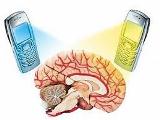Small brain cancer risk for cell phone users – WHO

The World Health Organisation (WHO)’s International Agency for Research on Cancer (IARC), say there is a possibility that exposures to radiofrequency electromagnetic fields, such as those emitted by wireless phones (cell phones) might induce long’term health effects, in particular an increased risk for glioma, a malignant type of brain cancer.
The IARC said that over the past few years, there has been mounting concern about the possibility of adverse health effects resulting from exposure to radiofrequency electromagnetic fields.
The number of mobile phone subscriptions is estimated at 5 billion globally with young children and adults increasingly exposed.
The statement follows a meeting of 31 scientists from 14 countries in France last month, to assess the potential carcinogenic hazards from exposure to radiofrequency electromagnetic fields. The Working Group discussed and evaluated the available literature on exposures involving these fields. These included occupational exposures to radar and microwaves, environmental exposures associated with transmission of signals for radio, television and wireless telecommunication, and personal exposures associated with the use of wireless telephones. They also investigated the exposure data, the studies of cancer in humans, the studies of cancer in experimental animals, and the mechanistic and other relevant data.
‘The evidence and results were reviewed critically, and overall evaluated as being limited among users of wireless telephones for glioma and acoustic neuroma, a slow growing non-cancerous tumour that develops on the nerve that connects the ear to the brain,’ the WHO said.
The group said the information they reviewed was inadequate to draw conclusions for other types of cancers. They also did not quantitate the risk, however, one study of past cell phone use (up to the year 2004), showed a 40% increased risk for gliomas in the highest category of heavy users (reported average: 30 minutes per day over a 10’year period).
Dr Jonathan Samet of the University of Southern California, USA, and Chairman of the Working Group, indicated that ‘the evidence, while still accumulating, is strong enough to support a conclusion that there could be some risk of developing cancer due to mobile phone use.’ ‘Therefore, we need to keep a close watch for a link between cell phones and cancer risk,’ said Samet.
‘Given the potential consequences for public health of these findings, it is important that additional research be conducted into the long’term, heavy use of mobile phones,” said IARC Director, Christopher Wild. He said pending the availability of such information, it is important to take pragmatic measures to reduce exposures such as hands’free devices or texting.
*The International Agency for Research on Cancer (IARC) is part of the World Health Organization. Its mission is to coordinate and conduct research on the causes of human cancer, the mechanisms of carcinogenesis, and to develop scientific strategies for cancer control.
For more information, click here:
http://www.cancer.org/Cancer/CancerCauses/O
http://www.youtube.com/watch?v=9JEd-V1qdpE
Author

Health-e News is South Africa's dedicated health news service and home to OurHealth citizen journalism. Follow us on Twitter @HealtheNews
Republish this article
This work is licensed under a Creative Commons Attribution-NoDerivatives 4.0 International License.
Unless otherwise noted, you can republish our articles for free under a Creative Commons license. Here’s what you need to know:
You have to credit Health-e News. In the byline, we prefer “Author Name, Publication.” At the top of the text of your story, include a line that reads: “This story was originally published by Health-e News.” You must link the word “Health-e News” to the original URL of the story.
You must include all of the links from our story, including our newsletter sign up link.
If you use canonical metadata, please use the Health-e News URL. For more information about canonical metadata, click here.
You can’t edit our material, except to reflect relative changes in time, location and editorial style. (For example, “yesterday” can be changed to “last week”)
You have no rights to sell, license, syndicate, or otherwise represent yourself as the authorized owner of our material to any third parties. This means that you cannot actively publish or submit our work for syndication to third party platforms or apps like Apple News or Google News. Health-e News understands that publishers cannot fully control when certain third parties automatically summarise or crawl content from publishers’ own sites.
You can’t republish our material wholesale, or automatically; you need to select stories to be republished individually.
If you share republished stories on social media, we’d appreciate being tagged in your posts. You can find us on Twitter @HealthENews, Instagram @healthenews, and Facebook Health-e News Service.
You can grab HTML code for our stories easily. Click on the Creative Commons logo on our stories. You’ll find it with the other share buttons.
If you have any other questions, contact info@health-e.org.za.
Small brain cancer risk for cell phone users – WHO
by Health-e News, Health-e News
June 1, 2011
MOST READ
FS woman waits 4 years for medical negligence pay out after ‘out of court settlement’
Prolonged power outage leaves hospitals in the dark for two days
There’s more to self-care than scented candles or massages, it’s a key public health tool
Access to clean water and stable electricity could go a long way to addressing rising food poisoning in SA
EDITOR'S PICKS
Related


Malnutrition in South Africa: how one community wants resources to be spent

